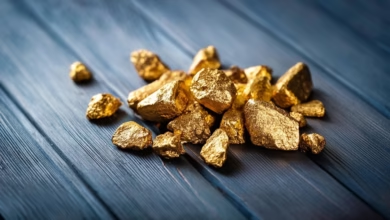Gold Trade Routes: Exploring Historical Pathways and Modern Strategies for Gold Investment

Gold has captivated humanity for centuries, serving not only as a symbol of wealth and power but also as a critical component in trade and commerce. From the ancient Silk Road to modern financial markets, the pathways of gold trade have evolved dramatically, reflecting shifts in economic landscapes and cultural values. In this article, we will explore the historical gold trade routes that shaped ancient civilizations and their significance in today's global economy. We will also delve into the current gold market trends, analyzing how fluctuations in gold prices affect investment strategies, including gold ETFs and gold futures. Furthermore, we will address the pressing issue of sustainable gold mining, highlighting the balance between meeting global gold demand and addressing ethical concerns surrounding gold production. Whether you are an investor looking to diversify your portfolio with physical gold or a collector interested in luxury gold jewelry and gold coins, understanding the intricacies of the gold trade is essential in navigating its complexities in an ever-changing financial world. Join us as we uncover the past, present, and future of gold commerce.
- 1. Historical Gold Trade Routes: From Ancient Civilizations to Modern Commerce
- 2. The Impact of Gold Market Trends on Investment Strategies: Navigating Gold Prices Today
- 3. Sustainable Gold Mining and the Future of Gold Trade: Addressing Global Demand and Ethical Concerns
1. Historical Gold Trade Routes: From Ancient Civilizations to Modern Commerce
Throughout history, gold has been a highly sought-after metal, valued not only for its beauty but also for its economic significance. The historical gold trade routes have played a pivotal role in shaping civilizations and economies, facilitating the movement of this precious metal from ancient mines to modern markets.
In ancient times, gold was often mined in regions rich in natural resources, such as Egypt, Nubia, and Mesopotamia. These civilizations established extensive trade networks, exchanging gold for goods and services. For instance, the famous Silk Road connected the East and West, enabling the flow of gold, spices, and luxury items, which laid the groundwork for the global gold demand we see today.
As societies evolved, so did the methods of gold trade. The establishment of the gold standard in the 19th century further solidified gold's role as a safe haven asset. Central banks began accumulating gold reserves to stabilize their currencies, leading to the creation of gold bullion and gold coins as standard currency forms. This period also saw the rise of gold investment opportunities, such as gold ETFs and gold futures, making it easier for investors to participate in the gold market without needing to hold physical gold.
In modern commerce, gold remains a critical component of the global economy. The gold market analysis indicates that fluctuations in gold prices can often correlate with economic instability, inflation, and geopolitical tensions. Investors frequently turn to gold as a hedge against inflation and economic uncertainty, reinforcing its status as a safe haven asset.
Moreover, sustainable gold mining practices have become increasingly important in today’s environmentally conscious market. The shift towards ethical sourcing and gold recycling has garnered attention, as consumers demand transparency regarding the origins of their gold jewelry and collectibles. The rise of luxury gold items and gold technology, such as in electronics, has also contributed to diversifying the uses of gold beyond traditional investment.
However, challenges such as gold smuggling and illegal mining threaten the integrity of the gold trade. As illicit activities persist, global efforts aim to regulate and promote responsible gold production, ensuring that the economic benefits of gold reach the communities involved in its extraction.
In summary, the historical gold trade routes have evolved significantly, transitioning from ancient civilizations to a complex modern marketplace. Today, gold continues to be a vital asset, influencing economic policies, investment strategies, and consumer behavior across the globe. Understanding these historical pathways helps us appreciate the multifaceted role of gold in our economy and its enduring appeal as a valuable resource.
2. The Impact of Gold Market Trends on Investment Strategies: Navigating Gold Prices Today
The landscape of gold investment is continually shaped by evolving gold market trends, which significantly impact how investors approach the gold industry today. As gold prices fluctuate, influenced by various economic factors including inflation, geopolitical tensions, and currency valuation, investors must adapt their strategies to optimize their returns.
In recent years, gold has emerged as a safe haven asset, particularly during periods of economic uncertainty. Investors often turn to physical gold, such as gold bullion and gold coins, as a hedge against inflation and market volatility. The enduring appeal of gold jewelry and luxury gold items further underscores the global gold demand, which remains robust even in challenging economic climates.
Gold ETFs (Exchange-Traded Funds) have gained popularity as a flexible investment option, allowing individuals to invest in gold without the need for physical storage. These financial instruments mirror gold prices, making them an effective way to gain exposure to gold market trends. Additionally, gold futures contracts offer another avenue for investors looking to speculate on future gold prices.
The role of central banks in the gold market cannot be understated. Many central banks hold substantial gold reserves as part of their monetary policy, reflecting a commitment to gold standards in times of economic instability. This institutional demand contributes to the overall market dynamics and influences gold production levels.
On the other hand, the rise of cryptocurrency has introduced new considerations for gold investment. While some investors view cryptocurrencies as a modern alternative to gold, traditionalists argue that gold remains the superior store of value, particularly in times of inflation. The interplay between gold and cryptocurrency continues to evolve, impacting investment strategies.
Moreover, issues like gold smuggling and ethical concerns surrounding gold mining practices have prompted discussions about sustainable gold mining. Investors are increasingly looking for transparency in gold sourcing, with a growing interest in gold recycling and the responsible sourcing of gold, particularly in the context of gold technology and refining processes.
In summary, navigating the current gold market necessitates a comprehensive understanding of gold market trends, gold prices, and the various investment vehicles available. By staying informed and adapting strategies to these trends, investors can effectively position themselves in the dynamic world of gold investment, whether through gold coins investing, gold bars, or exploring the potential of gold collectibles.
3. Sustainable Gold Mining and the Future of Gold Trade: Addressing Global Demand and Ethical Concerns
As global gold demand continues to rise, the future of gold trade is increasingly intertwined with sustainable practices and ethical concerns. Sustainable gold mining is essential for balancing environmental stewardship with the need for gold as a safe haven asset. The gold market is witnessing a shift towards ethical sourcing, as investors and consumers become more conscious of the impacts of gold mining on communities and ecosystems.
The gold mining industry faces scrutiny for its environmental footprint, which includes habitat destruction, water pollution, and greenhouse gas emissions. To address these challenges, many companies are adopting sustainable gold mining practices that minimize harm and promote responsible resource management. This shift is not only beneficial for the environment but is also becoming a key factor in gold investment decisions. Investors are now more inclined to support gold mining operations that prioritize sustainability, as it aligns with the growing trend of socially responsible investing.
Moreover, the rise of gold recycling has opened new avenues for sustainable gold production. By reclaiming gold from old jewelry, electronics, and other products, the industry can reduce reliance on newly mined gold, thus alleviating some pressure on natural resources. This practice also contributes to the stability of gold prices by ensuring a steady supply in the market without the environmental costs associated with traditional mining.
As central banks continue to hold and increase their gold reserves, they are also taking into account the sustainability of gold production. This awareness is reflected in gold market trends where ethical sourcing is valued alongside traditional attributes such as purity and weight in gold bars and gold coins. Additionally, gold ETFs and gold futures are becoming more popular among investors looking to diversify their portfolios while considering the implications of their investments on global issues.
The intersection of gold and technology has also introduced innovative solutions to enhance sustainability in the gold trade. Advanced gold refining techniques are being developed to extract gold with minimal impact on the environment, while blockchain technology is being explored to ensure transparency in gold trading and to combat gold smuggling.
In the context of inflation and economic uncertainty, gold remains a robust safe haven asset. As global gold demand escalates, the industry must respond with a commitment to sustainable practices that ensure the longevity of gold as a commodity. By addressing ethical concerns and promoting responsible mining and recycling, the future of gold trade can be aligned with the values of modern investors who seek to balance profit with purpose.
In conclusion, the future of gold trade will depend on the industry's ability to adapt to changing consumer expectations around sustainability. By embracing ethical practices and innovative technologies, the gold market can not only meet global demand but also contribute positively to the environment and society as a whole. As we move forward, the importance of sustainable gold mining will play a crucial role in shaping the landscape of gold investment and the overall gold market analysis.
References:
– World Gold Council. (2023). Sustainable Gold. Retrieved from [World Gold Council](https://www.gold.org)
– International Council on Mining and Metals. (2022). Mining and Sustainable Development. Retrieved from [ICMM](https://www.icmm.com)
– United Nations Environment Programme. (2021). Sustainable Development Goals and Gold Mining. Retrieved from [UNEP](https://www.unep.org)
In conclusion, the evolution of gold trade routes has played a pivotal role in shaping both historical and modern commerce, making gold a timeless and invaluable asset. From ancient civilizations that utilized these pathways for trading gold coins and jewelry to today's complex network that supports gold investment strategies, the significance of gold remains unchallenged. As we navigate the current gold market trends, understanding the fluctuations in gold prices is crucial for investors seeking to leverage gold as a safe haven asset, particularly in times of economic uncertainty and inflation.
Furthermore, the future of gold trade is intricately linked to sustainable gold mining practices that address ethical concerns and global gold demand. By embracing innovative technologies for gold refining and recycling, we can ensure that the industry remains responsible and responsive to the needs of both investors and the environment. As central banks continue to build their gold reserves and the popularity of gold ETFs and futures rises, it is clear that gold will maintain its status as a cornerstone of wealth and a hedge against market volatility.
As we look ahead, the interplay between gold and emerging assets, such as cryptocurrency, will likely redefine investment landscapes, while luxury gold collectibles and bullion will continue to attract enthusiasts and investors alike. Ultimately, understanding the historical context and modern implications of gold trade is essential for anyone looking to navigate the complexities of gold investment successfully. Engaging with these themes will not only enhance your knowledge of gold's role in the global economy but also empower you to make informed decisions in your investment journey.





